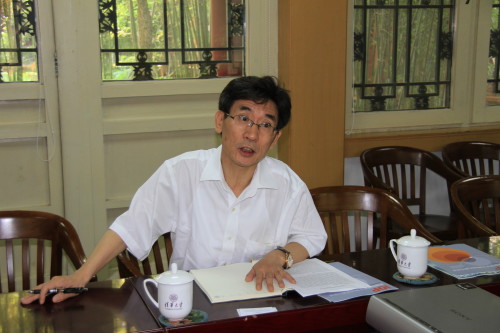
Figures at the ready: Qi-Kun Xue from Tsinghua University, which has 40,000 students. (Courtesy: Mingfang Lu)
By Matin Durrani in Beijing, China
I like big cities so I feel quite at home in Beijing with its skyscrapers, highways and endless traffic. Still, it was a pleasure yesterday on the third day of my visit to the Chinese capital to arrive at the green lawns of Tsinghua University. Situated in a former imperial garden, the university was founded in 1911 and is one of the top institutions in the country. According to the 2015–16 Times Higher Education rankings, it’s also the fifth best in Asia.
Quite why Tsinghua is so well rated quickly became clear as I listened to the numbers reeled off by Tsinghua’s vice-president for research Qi-Kun Xue: the university has 6000 research faculty and staff, a total research budget of $700m, and more than 40,000 students (two-thirds at postgraduate level). Like much of modern China, it’s benefiting from the government’s long-term commitment to growth through investment in facilities and infrastructure.
The physics department alone has 400 undergraduates, 300 graduate students and 80 faculty, who specialize in condensed-matter physics, atomic, molecular and optical physics, and astronomy, nuclear and particle physics. Not bad given that the department, which was originally founded in 1926, was disbanded in 1952 after it had been decided that Tsinghua should focus on teaching and engineering (not scientific research) and only re-opened in 1982.
Tsinghua’s growth over the last few decadess has been impressive. Competition for places at undergraduate level is fierce and the university has its pick of some of the best students from all over this vast country. New facilities and faculties are opening up all the time, with the physics department set to move to a new building in 2019.
The university also has its own Institute for Advanced Study, as its vice-director Zheng-Yu Weng explained over an obligatory cup of green tea. Modelled on the IAS at Princeton University, where Einstein was once based, its research strengths lie in areas such as cold-atom physics and quantum gravity. The institute’s honorary director is the Chinese Nobel-prize-winning physicist Chen-Ning Yang – who once studied at Tsinghua and has supported the institute since it was set up in 1997.
All of which goes to show just why China is so good at physics these days. Top facilities. Lots of money sloshing about. And big expansion ideas. It’s quite simple really and a recipe other nations would do well to heed.
To its credit, Tsinghua Univ. works on cold fusion also.